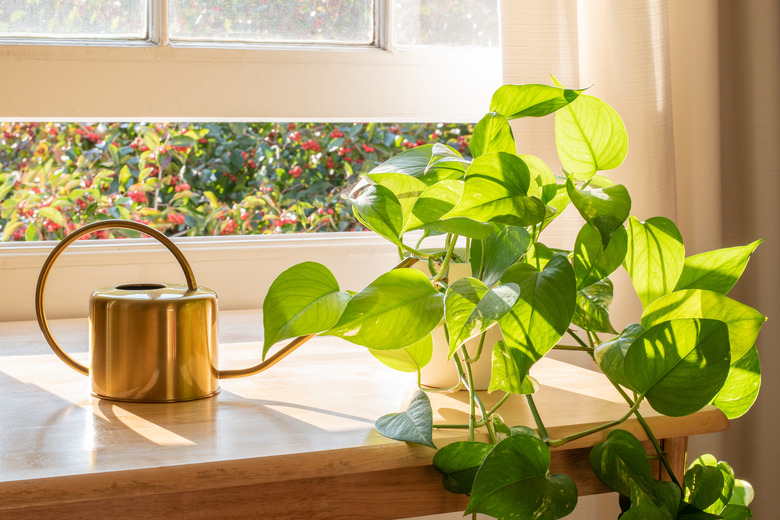How To Kill Bugs On An Ivy Plant
We may receive a commission on purchases made from links.
The trailing vines of ivy make it an attractive ground cover or in the case of the smaller cultivars, a vigorous houseplant. Hardy in U.S. Department of Agriculture plant hardiness zones 4 through 9 depending on genus, species, and cultivar, the mass of vines and leaves may hide an assortment of pests. To kill bugs on an ivy plant, try the least toxic methods first, such as hand-picking the pests, wiping the leaves with a cloth dipped in rubbing alcohol or dipping the foliage in a solution of water and dishwashing liquid.
Types of Ivy
Types of Ivy
The ivy planted most often in North America and Europe is the English ivy (Hedera helix), a perennial in USDA zones 4 through 9. With a multitude of cultivars, in various shades of yellow-green and green to variegated to curly leafed, it scrambles up walls and spreads over bare soil in part to full shade. If allowed to mature, in seven to 10 years, English ivy will grow into a small bush or tree, flower and produce berries. This plant is so aggressive that it's on the invasive weed list in many states; responsible gardeners avoid planting this ivy.
Hardy in USDA zones 5 through 9, Irish ivy (Hedera hibernica) has larger leaves than English ivy and spreads just as far on vines that may reach 100 feet or more. Persian ivy (Hedera colchica) and Algerian or Canary ivy (Hedera canariensis) thrive in USDA zones 5 through 9 and 7 through 9, respectively. The 4- to 10-inch heart-shaped leaves of Persian ivy may be solid green or variegated depending on the cultivar. If you're looking for color, the Japanese ivy (Hedera rhombea) produces green or cream and green variegated leaves on purple stems in USDA zones 8 and 9. Boston ivy (Parthenocissus tricuspidata) is a deciduous ivy that sports brilliant fall foliage color.
Bugs on an Ivy Plant
Bugs on an Ivy Plant
Ivy plants suffer from the common houseplant pests plus slugs and snails when grown in the garden. The moist soil and shady site allow the slimy pests to proliferate amid the ivy's foliage. Hand-pick snails and slugs or put out yeast traps to attract and drown the pests.
Spider mites thrive in the warm, dry, dusty air of the average home. The leaves turn yellow, and you may see speckles near the base of the foliage. In severe cases, you can see telltale webbing on the leaves, which turn brown and die.
Other sap-sucking bugs include aphids, mealybugs, scale and whiteflies. The ivy leaves may turn yellow and become deformed when infested with these insects. Aphids produce sticky honeydew, which feeds sooty mold fungi and leaves dark splotches on the plant. You can see the pale, cotton-appearing mealybugs on the leaves and stems, while the tiny whiteflies flutter around the plant when disturbed.
Standard Safety Precautions
Standard Safety Precautions
Before you begin, put on safety goggles, long sleeves and gloves. If working outside, also put on long pants and closed-toe shoes. English ivy can cause contact dermatitis in sensitive individuals, including severe skin irritation and blisters. All parts of the plant contain saponins and other compounds that are toxic to cats, dogs, horses and humans, so keep them out of the reach of children and pets.
Sterilize your cutting tools by dipping the blades into rubbing alcohol before pruning or trimming insect-damaged or diseased stems and leaves. Put infested or infected plant debris in the trash, not on the compost pile.
How to Kill Bugs on Ivy
How to Kill Bugs on Ivy
The simplest way to control bugs on ivy is to wash the foliage regularly. When the weather is hot and dry, blast off aphids, spider mites and other bugs with a strong stream of cold water.
If plain water isn't working, step up the game by dipping a clean rag in rubbing alcohol and wiping the foliage to remove scale and mealybugs. Be sure to wipe the stems where they meet the leaves. Rinse with lukewarm water to remove the dead bugs and alcohol residue.
For severe mite infestations, take houseplants outside and apply a miticide. Use according to the package instructions and apply when the air is still and temperatures are less than 90 degrees Fahrenheit. Spray the leaves top and bottom to ensure the solution contacts the bugs. Allow houseplants to air dry before taking them back inside.
